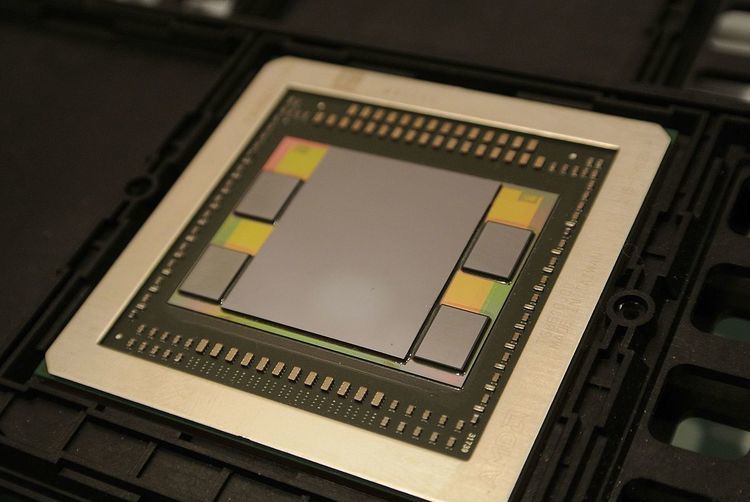Release date 16 June 2015 | Architecture GCN 3rd gen | |
 | ||
Codename Caribbean Islands
Sea Islands
Volcanic Islands Entry-level Radeon R5 330
Radeon R5 340
Radeon R7 340
Radeon R7 350 Mid-range Radeon R7 360
Radeon R7 370
Radeon R9 380
Radeon R9 380X High-end Radeon R9 390
Radeon R9 390X | ||
AMD Radeon Rx 300 is a brand for a series of graphics cards. All used GPUs have been developed by AMD, produced in 28 nm and belong to the same microarchitecture family: Graphics Core Next (GCN).
Contents
- Core architecture
- Ancillary ASICs
- Multi monitor support
- AMD TrueAudio
- Video acceleration
- Frame limiter
- LiquidVR support
- Virtual super resolution support
- Desktop products
- Mobile products
- AMDs proprietary graphics device driver Catalyst
- Free and open source graphics device driver Radeon
- References
Devices based on the Fiji architecture, which include the flagship AMD Radeon R9 Fury X along with the Radeon R9 Fury and Radeon R9 Nano, are the first GPUs to feature High Bandwidth Memory (HBM) technology which is faster and more power efficient than current GDDR5 memory. However, the Rx 300-numbered GPUs in the series are based on previous generation GPUs with revised power management and therefore only feature GDDR5 memory. The Radeon 300 series cards including the R9 390X were released on June 18, 2015. The flagship device, Fury X, was released on June 24, 2015, with the dual-GPU variant, the Radeon Pro Duo, being released the following year on April, 26th, 2016.
Core architecture
There are chips implementing all three iterations of Graphics Core Next. The table below details which GCN-generation each chip belongs to.
Ancillary ASICs
Any ancillary ASICs present on the chips are being developed independently of the core architecture and have their own version name schemes.
Multi-monitor support
The AMD Eyefinity-branded on-die display controllers were introduced in September 2009 in the Radeon HD 5000 Series and have been present in all products since.
AMD TrueAudio
AMD TrueAudio was introduced with the AMD Radeon Rx 200 Series, but can only be found on the dies of GCN 1.1 and later products.
Video acceleration
AMD's SIP core for video acceleration, Unified Video Decoder and Video Coding Engine, are found on all GPUs and are supported by AMD Catalyst and by the open-source Radeon graphics driver.
Frame limiter
A completely new feature to the lineup allows users to reduce power consumption by not rendering unnecessary frames. It will be user configurable.
LiquidVR support
LiquidVR is a technology that improves the smoothness of virtual reality. The aim is to reduce latency between hardware so that the hardware can keep up with the user's head movement, eliminating the motion sickness. A particular focus is on dual GPU setups where each GPU will now render for one eye individually of the display.
Virtual super resolution support
Originally introduced with the previous generation R9 285 and R9 290 series graphics cards, this feature allows users to run games with higher image quality by rendering frames at above native resolution. Each frame is then downsampled to native resolution. This process is an alternative to supersampling which is not supported by all games. Virtual super resolution is similar to Dynamic Super Resolution, a feature available on competing nVidia graphics cards, but trades flexibility for increased performance.
Desktop products
See below:
Mobile products
See below:
AMD's proprietary graphics device driver "Catalyst"
AMD Catalyst is being developed for Microsoft Windows and Linux. As of July 2014, other operating systems are not officially supported. This may be different for the AMD FirePro brand, which is based on identical hardware but features OpenGL-certified graphics device drivers.
AMD Catalyst supports all features advertised for the Radeon brand.
Free and open-source graphics device driver "Radeon"
The free and open-source drivers are primarily developed on Linux and for Linux, but have been ported to other operating systems as well. Each driver is composed out of five parts:
- Linux kernel component DRM
- Linux kernel component KMS driver: basically the device driver for the display controller
- user-space component libDRM
- user-space component in Mesa 3D
- a special and distinct 2D graphics device driver for X.Org Server, which is finally about to be replaced by Glamor
The free and open-source "Radeon" graphics driver supports most of the features implemented into the Radeon line of GPUs.
The free and open-source "Radeon" graphics device drivers are not reverse engineered, but based on documentation released by AMD. These drivers still require proprietary microcode to operate DRM functions and some GPUs may fail to launch the X server if not available.
